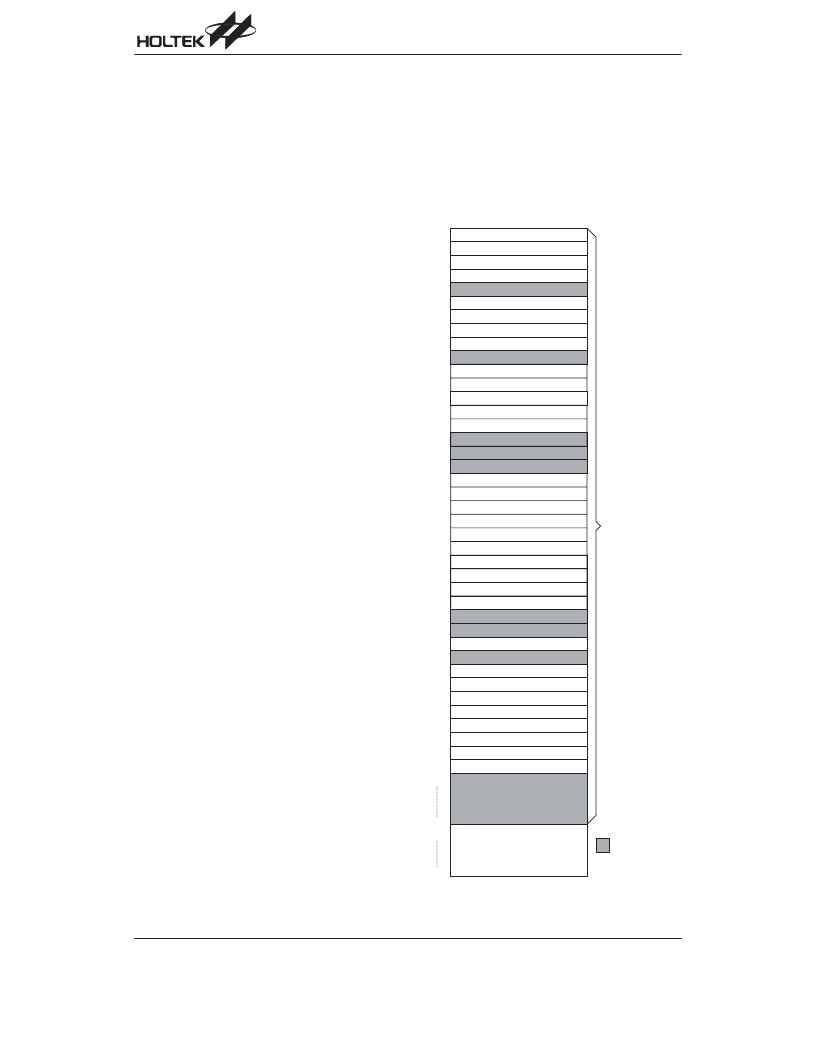- 您現(xiàn)在的位置:買賣IC網(wǎng) > PDF目錄385399 > HT46C23 (Holtek Semiconductor Inc.) A/D Type 8-Bit MCU PDF資料下載
參數(shù)資料
| 型號(hào): | HT46C23 |
| 廠商: | Holtek Semiconductor Inc. |
| 英文描述: | A/D Type 8-Bit MCU |
| 中文描述: | 的A / D型8位微控制器 |
| 文件頁(yè)數(shù): | 8/48頁(yè) |
| 文件大小: | 348K |
| 代理商: | HT46C23 |
第1頁(yè)第2頁(yè)第3頁(yè)第4頁(yè)第5頁(yè)第6頁(yè)第7頁(yè)當(dāng)前第8頁(yè)第9頁(yè)第10頁(yè)第11頁(yè)第12頁(yè)第13頁(yè)第14頁(yè)第15頁(yè)第16頁(yè)第17頁(yè)第18頁(yè)第19頁(yè)第20頁(yè)第21頁(yè)第22頁(yè)第23頁(yè)第24頁(yè)第25頁(yè)第26頁(yè)第27頁(yè)第28頁(yè)第29頁(yè)第30頁(yè)第31頁(yè)第32頁(yè)第33頁(yè)第34頁(yè)第35頁(yè)第36頁(yè)第37頁(yè)第38頁(yè)第39頁(yè)第40頁(yè)第41頁(yè)第42頁(yè)第43頁(yè)第44頁(yè)第45頁(yè)第46頁(yè)第47頁(yè)第48頁(yè)

HT46R23/HT46C23
Rev. 1.60
8
May 3, 2004
If the stack is full and a non-masked interrupt takes
place, the interrupt request flag will be recorded but the
acknowledgment will be inhibited. When the stack
pointer is decremented (by RET or RETI), the interrupt
will be serviced. This feature prevents stack overflow al-
lowing the programmer to use the structure more easily.
In a similar case, if the stack is full and a CALL is sub-
sequently executed, stack overflow occurs and the first
entry will be lost (only the most recent 8 return ad-
dresses are stored).
Data Memory
RAM
The data memory is designed with 224 8 bits. The
data memory is divided into two functional groups: spe-
cial function registers and general purpose data mem-
ory (192 8). Most are read/write, but some are read
only.
The special function registers include the indirect ad-
dressing registers (00H;02H), timer/event counter
higher-order byte register (TMRH;0CH), timer/event
counter low-order byte register (TMRL;0DH),
timer/event counter control register (TMRC;0EH), pro-
gram counter lower-order byte register (PCL;06H),
memory pointer registers (MP0;01H, MP1;03H), accu-
mulator (ACC;05H), table pointer (TBLP;07H), table
higher-order byte register (TBLH;08H), status register
(STATUS;0AH), interrupt control register 0 (INTC0;
0BH), PWM data register (PWM0;1AH, PWM1;1BH),
the I
2
C Bus slave address register (HADR;20H), the I
2
C
Bus control register (HCR;21H), the I
2
C Bus status reg-
ister (HSR;22H), the I
2
C Bus data register (HDR;23H),
the A/D result lower-order byte register (ADRL;24H), the
A/D result higher-order byte register (ADRH;25H), the
A/D control register (ADCR;26H), the A/D clock setting
register (ACSR;27H), I/O registers (PA;12H, PB;14H,
PC;16H, PD;18H) and I/O control registers (PAC;13H,
PBC;15H, PCC;17H, PDC;19H). The remaining space
before the 40H is reserved for future expanded usage
and reading these locations will get 00H . The general
purpose data memory, addressed from 40H to FFH, is
used for data and control information under instruction
commands.
All of the data memory areas can handle arithmetic,
logic, increment, decrement and rotate operations di-
rectly. Except for some dedicated bits, each bit in the
data memory can be set and reset by SET [m].i and
CLR [m].i . They are also indirectly accessible through
memory pointer registers (MP0;01H/MP1;03H).
Indirect Addressing Register
Location 00H and 02H are indirect addressing registers
that are not physically implemented. Any read/write op-
eration of [00H] or [02H] will access data memory
pointed to by MP0[01H] or MP1[03H] respectively.
Reading location 00H or 02H itself indirectly will return
the result 00H. Writing indirectly result in no operation.
The memory pointer registers (MP0 and MP1 are 8-bit
registers).
Accumulator
The accumulator is closely related to ALU operations. It
is also mapped to location 05H of the data memory and
can carry out immediate data operations. The data
movement between two data memory locations must
pass through the accumulator.
# " % $ .
#
( "
7
>
>
>
0 >
>
>
2 >
/ >
3 >
8 >
>
>
>
>
>
1 >
>
>
>
0 >
>
>
2 >
/ >
3 >
8 >
>
>
>
>
>
1 >
B
! ( " )
"
)
( C
C
- " ! "
.
#
( "
7
9 8
' " ( :
1 1 >
>
>
>
>
0 >
>
>
2 >
/ >
3 >
0 1 >
! ) $ " %
) ) " ( ( $ !
"
$ ( "
! ) $ " %
) ) " ( ( $ !
"
$ ( "
*
*
* >
>
*
>
>
>
>
*
>
RAM Mapping
相關(guān)PDF資料 |
PDF描述 |
|---|---|
| HT46C24 | A/D Type 8-Bit MCU |
| HT46R24 | A/D Type 8-Bit MCU |
| HT46C46 | Cost-Effective A/D Type 8-Bit MCU |
| HT46C47 | Cost-Effective A/D Type 8-Bit MCU |
| HT46R46 | Cost-Effective A/D Type 8-Bit MCU |
相關(guān)代理商/技術(shù)參數(shù) |
參數(shù)描述 |
|---|---|
| HT46C232 | 制造商:HOLTEK 制造商全稱:Holtek Semiconductor Inc 功能描述:A/D Type 8-Bit MCU |
| HT46C24 | 制造商:HOLTEK 制造商全稱:Holtek Semiconductor Inc 功能描述:A/D Type 8-Bit MCU |
| HT46C46 | 制造商:HOLTEK 制造商全稱:Holtek Semiconductor Inc 功能描述:Cost-Effective A/D Type 8-Bit MCU |
| HT46C46E | 制造商:HOLTEK 制造商全稱:Holtek Semiconductor Inc 功能描述:Cost-Effective A/D Type 8-Bit MCU |
| HT46C47 | 制造商:HOLTEK 制造商全稱:Holtek Semiconductor Inc 功能描述:Cost-Effective A/D Type 8-Bit MCU |
發(fā)布緊急采購(gòu),3分鐘左右您將得到回復(fù)。